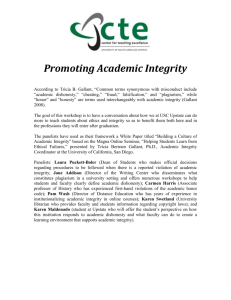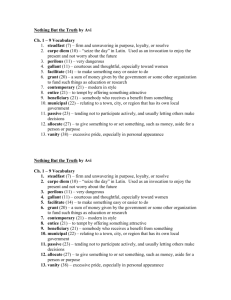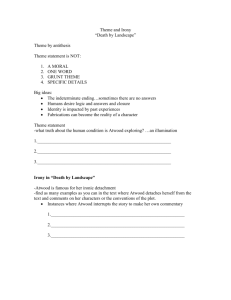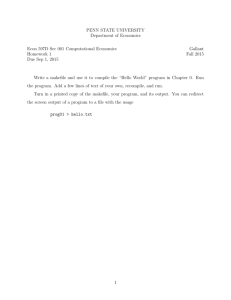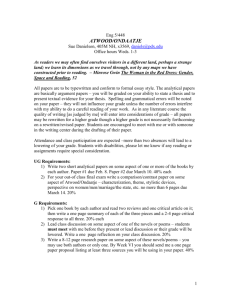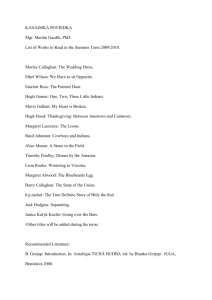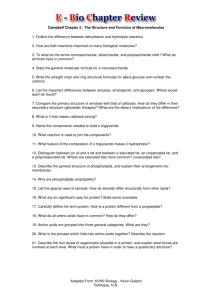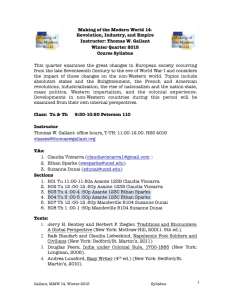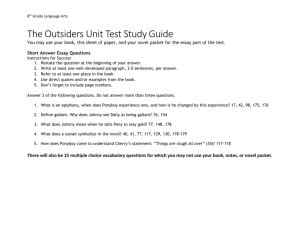Margaret Atwood
advertisement
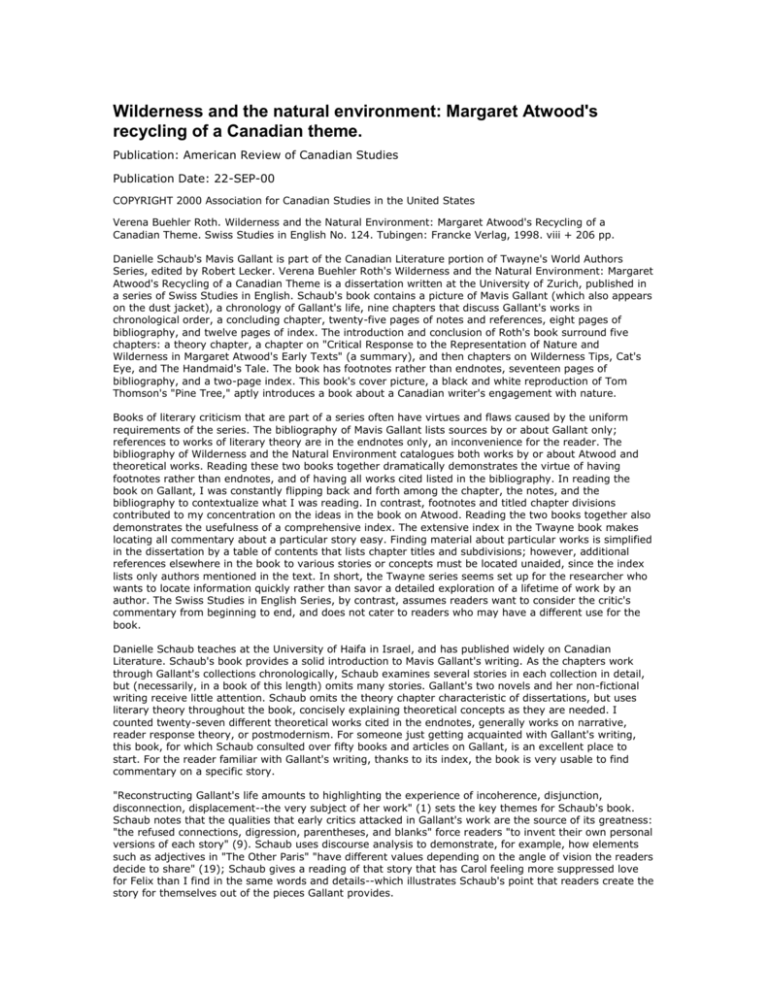
Wilderness and the natural environment: Margaret Atwood's recycling of a Canadian theme. Publication: American Review of Canadian Studies Publication Date: 22-SEP-00 COPYRIGHT 2000 Association for Canadian Studies in the United States Verena Buehler Roth. Wilderness and the Natural Environment: Margaret Atwood's Recycling of a Canadian Theme. Swiss Studies in English No. 124. Tubingen: Francke Verlag, 1998. viii + 206 pp. Danielle Schaub's Mavis Gallant is part of the Canadian Literature portion of Twayne's World Authors Series, edited by Robert Lecker. Verena Buehler Roth's Wilderness and the Natural Environment: Margaret Atwood's Recycling of a Canadian Theme is a dissertation written at the University of Zurich, published in a series of Swiss Studies in English. Schaub's book contains a picture of Mavis Gallant (which also appears on the dust jacket), a chronology of Gallant's life, nine chapters that discuss Gallant's works in chronological order, a concluding chapter, twenty-five pages of notes and references, eight pages of bibliography, and twelve pages of index. The introduction and conclusion of Roth's book surround five chapters: a theory chapter, a chapter on "Critical Response to the Representation of Nature and Wilderness in Margaret Atwood's Early Texts" (a summary), and then chapters on Wilderness Tips, Cat's Eye, and The Handmaid's Tale. The book has footnotes rather than endnotes, seventeen pages of bibliography, and a two-page index. This book's cover picture, a black and white reproduction of Tom Thomson's "Pine Tree," aptly introduces a book about a Canadian writer's engagement with nature. Books of literary criticism that are part of a series often have virtues and flaws caused by the uniform requirements of the series. The bibliography of Mavis Gallant lists sources by or about Gallant only; references to works of literary theory are in the endnotes only, an inconvenience for the reader. The bibliography of Wilderness and the Natural Environment catalogues both works by or about Atwood and theoretical works. Reading these two books together dramatically demonstrates the virtue of having footnotes rather than endnotes, and of having all works cited listed in the bibliography. In reading the book on Gallant, I was constantly flipping back and forth among the chapter, the notes, and the bibliography to contextualize what I was reading. In contrast, footnotes and titled chapter divisions contributed to my concentration on the ideas in the book on Atwood. Reading the two books together also demonstrates the usefulness of a comprehensive index. The extensive index in the Twayne book makes locating all commentary about a particular story easy. Finding material about particular works is simplified in the dissertation by a table of contents that lists chapter titles and subdivisions; however, additional references elsewhere in the book to various stories or concepts must be located unaided, since the index lists only authors mentioned in the text. In short, the Twayne series seems set up for the researcher who wants to locate information quickly rather than savor a detailed exploration of a lifetime of work by an author. The Swiss Studies in English Series, by contrast, assumes readers want to consider the critic's commentary from beginning to end, and does not cater to readers who may have a different use for the book. Danielle Schaub teaches at the University of Haifa in Israel, and has published widely on Canadian Literature. Schaub's book provides a solid introduction to Mavis Gallant's writing. As the chapters work through Gallant's collections chronologically, Schaub examines several stories in each collection in detail, but (necessarily, in a book of this length) omits many stories. Gallant's two novels and her non-fictional writing receive little attention. Schaub omits the theory chapter characteristic of dissertations, but uses literary theory throughout the book, concisely explaining theoretical concepts as they are needed. I counted twenty-seven different theoretical works cited in the endnotes, generally works on narrative, reader response theory, or postmodernism. For someone just getting acquainted with Gallant's writing, this book, for which Schaub consulted over fifty books and articles on Gallant, is an excellent place to start. For the reader familiar with Gallant's writing, thanks to its index, the book is very usable to find commentary on a specific story. "Reconstructing Gallant's life amounts to highlighting the experience of incoherence, disjunction, disconnection, displacement--the very subject of her work" (1) sets the key themes for Schaub's book. Schaub notes that the qualities that early critics attacked in Gallant's work are the source of its greatness: "the refused connections, digression, parentheses, and blanks" force readers "to invent their own personal versions of each story" (9). Schaub uses discourse analysis to demonstrate, for example, how elements such as adjectives in "The Other Paris" "have different values depending on the angle of vision the readers decide to share" (19); Schaub gives a reading of that story that has Carol feeling more suppressed love for Felix than I find in the same words and details--which illustrates Schaub's point that readers create the story for themselves out of the pieces Gallant provides. Of the stories in The Other Paris and My Heart is Broken, Schaub writes, "with their clashing visions of life, the narratives generate and sustain tension through oppositions" between "romance and realism, ... liberalism and traditionalism, ... private and public face, ... pretended and real concern, ... selfishness and generosity, ... children and parents, ... inner life and external behavior, ... the past and its questionable recollections, ... and inner life and ideologies" (8). In discussing The Pegnitz Junction Schaub emphasizes how using multivoiced narration enables Gallant to give "a picture of postwar Germany that secures an enlightening dialogue between past and present, between history and fiction" (26). The chapter on Gallant's two novels hurries (after four and a half pages) into a discussion of stories in The End of the World, which contain comments which "can be read on two levels--the purely fictional relation of events and the metafictional interest in the process of creation" (74). Irony has a destabilizing effect in the stories in From the Fifteenth District, which are "peopled by characters with a dislocated sense of self, whose narrated lives display some discrepancy that forces the readers to question the received value of the represented" (75). In "Spatial Patterns of Displacement: Home Truths" Schaub contradicts her initial assertion that Gallant's "careful consideration of space is not unusual" (92) by concluding that the "overwhelming disjunction resulting from the stories' fictional space thus turns them into a model for Gallant's illustration of human dislocation" (118), a rather idiosyncratic use of space. Works of art represented in Overhead in a Balloon, "owing to the interaction between text and image," become multiply ironical, "one mode of representation reflecting the other almost ad infinitum, obviously depending on the readers' ability to see further layers of interrelation" (138). Schaub finds the apparent simplicity of language in In Transit deceptive, since the "structure of her [Gallant's] prose establishes conflicting tendencies that correspond to the transitory state of the characters and of the author herself" (162). For Schaub, the defining characteristic of Across the Bridge is that "while in earlier works Gallant catches the characters' flaws with admirable causticity, here she treats them with indulgence, fostering the readers' sympathy for the characters' shortcomings" (178). Verena Buehler Roth's thesis was accepted at the University of Zurich in the winter of 1996-97, making her a relative newcomer in Canadian studies. Her book wisely recognizes that much ground has already been covered by Atwood critics. Nevertheless, it seems odd, after a long theory chapter entitled "Nature and Wilderness in English-Canadian Literature and Criticism," to be told that the subject of nature and the environment in Atwood's early books has already received sufficient attention, so only a summary is needed. Although Roth's summary is helpful, what is the point of all the recent literary theory in the preceding chapter if it sheds no new light on material that other critics have commented on? Roth's discussion of three stories from Wilderness Tips sees "True Trash" as Romance, "Death by Landscape" as Gothic, and "Wilderness Tips" as Pastoral. She sees Atwood experimenting with "traditional ways of perceiving nature and landscape, such as in terms of the female body, as a threatening masculine force, antagonistic to a female striving for self-determination, as pastoral idyll or as sacred space" (61). In "True Trash" Atwood "makes a stab at the prevalent Canadian conception of a hostile and actively aggressive `male' nature" (66) by connecting female bodies with pink rocks (65). Atwood's use of the Pan myth in "Death by Landscape" "comments on a pantheistic world view" to suggest that union with nature is "self-obliterating" rather than desirable (83). In "Wilderness Tips" characters attempt to make Wacousta Lodge a sacred, pastoral place, "but Wacousta does not grant authentic, unalienated experience like a truly sacred place" (100). Roth sees Atwood creating an idyllic connection with the wilderness for the child Elaine in Cat's Eye, but then replacing wilderness with a city where nature exists mostly in threatening ravines, which are associated with other inimical spaces below ground level throughout the novel. Heights are equally negative. "Both places above the surface of the earth and places below it form a contrast to the horizontal dimension of Elaine's nomadic and happy childhood years" (143). Later in her life, "Vancouver replaces the forest wilderness of her childhood as a pastoral site" (146). The Handmaid's Tale "depicts an anti-natural dystopia" (182) in a world characterized by widespread ecological disaster. Tended flowers in gardens and stylized ones on wallpaper signal the imprisoning and unnatural world at the Commander's house (164-65). Wild flowers in pots and wild floral designs in the decor at Jezebel's mark its character as both wild and artificial (163). Roth connects particular flowers with individual characters: "the flowers in the garden with their cut-off seed-pods symbolize Serena Joy, and in the sensuality of the tulips Offred recognises herself" (166). Roth provides a close look at the material she covers, getting depth, especially with her commentary on Atwood's metaphors. Consider this paragraph, for example, concerning "True Trash": Another striking use of emblematic animal imagery is the association of Mr. B., the owner of the camp, with a hawk (because of its eyes) ... and a pike (because of its needle teeth). The latter is the mascot of the camp and it is always visible behind Mr. B's head during his speeches.... The parental control and the values of society at the summer camp, which Mr. B. represents, are thus conveyed with the violence of wild animals, on the one hand, and with the industriousness of bees (his name, "Mr. B") on the other. (76) Bees, however, sting, as Mr. B. stings Donny and also possibly Ronette; I connect his name with that of the man who tries to seduce the serving maid heroine of Samuel Richardson's Pamela, an association that focusing closely on wilderness and environment overlooks. Atwood not only uses description and imagery to set her stories in a physical environment, she also uses literary intertexts constantly to situate her stories within a literary and cultural framework. At times both Roth's and Schaub's readings prefer clarity in cases where I suspect the texts offer only unsettling ambiguity. Their discussions of rape in the stories of Atwood and Gallant respectively provide examples of this sort of simplification. In discussing the girl in the magazine story in Atwood's "True Trash," Roth writes that "when Dirk rapes her on the sofa the act is presented as if she had unconsciously wanted and even provoked it all along and that what happened is thus really her own fault" (67). Parts of the text support reading this as a rape: "I was frightened of him," "He looked like an animal stalking its prey," "I was pressed against the wall and he was crushing me in his arms"; however, other wording raises doubts about this construction: "My whole body was crying out for his," "Feebly I tried to push his hands away, but I didn't really want to," "we were One" (Atwood 8). Atwood's word choices require us think again about what we mean by date rape and consensual sex. The unresolved question becomes important later in the story. When Joanne finds it easy to say no to Perry, she longs for what Ronette shares with the girl in the magazine story: "the power to give herself up, without reservation and without commentary" (18); Joanne longs to lose that postmodern mindset in which all her actions are "surrounded by quotation marks" (19). The question here becomes not one of rape but of total engagement in overwhelming passion. Near the end of the story, we learn that Ronette seduced fourteen-year-old Donny. If the magazine scene was rape, is this child molestation? If the earlier scene described a consensual passionate coupling, we can read Donny's reaction as awed consent to his experience: "It's like sleepwalking, it's like running too fast, it's like nothing else" (29). Atwood's postmodernism offers us the possibility of making conflicting constructions from the details of the story, thereby engaging readers in contemporary issues that exist outside Atwood's fictions. Similarly, Gallant's "My Heart is Broken" provides conflicting ways of interpreting the story of a rape, and like Roth, Schaub chooses a reading that misses some of the story's subtlety. Schaub writes, "The readers must decode the narrative's indirection and digressions to learn that Jeannie's silences and apparent detachment conceal her heartbreak" (24). Yet Gallant states Jeannie's heartbreak quite clearly: "It's the first time in my life somebody hasn't liked me. My heart is broken" (Gallant 66). Gallant's point in ending the story with this comment, followed by Mrs. Thompson's nostalgic wondering if her heart has ever been broken, would seem to be to contrast Jeannie's experience of the violence of rape--"I was more beaten up" (64)--with what the older woman describes as "the most terrible shock I ever had in my life" (60), namely, hearing about the death of sex symbol Jean Harlow. Whereas Mrs. Thompson's experience is romantic and impersonal, Jeannie's is brutal and personal. Reading the story as if the irony were Victorian rather than postmodern, Schaub identifies the rapist: Mrs. Thompson fears "hearing who the victimizer is, lest it should be her husband, whose delight at listening to bawdy songs marks him as the likely lecher" (68). However, these songs are on records Mr. Thompson inherited from his mother, and the lyrics that Gallant presents are minimally ribald: "spooning in the park" (62). Perhaps the story does not identify the rapist because in fact he could have been any of the men, given the attitudes of society as expressed not only by men like Mr. Sherman (who suggests Jeannie invented the story) but also by women like Mrs. Thompson (who blames the victim), and as contained in movies and song lyrics. For me, this story blames a whole culture rather than any one person. In discussing these two stories, as elsewhere, both critics overlook the humor that characterizes the writing of both Atwood and Gallant. Atwood makes the sex scene from the supposed magazine hilariously satirical by interspersing mocking commentary by the waitresses, who wonder if the animal stalking its prey is a weasel or a skunk, and if the girl's body crying out to Dirk's says, "Hey, body, over here!" (8). Although Gallant treats Jeannie's rape as extremely serious, ridiculous touches such as Mrs. Thompson's airing Maureen, "the Thompson's youngest doll," in a pram (65) bring smiles to the lips of readers aware of the complexity of Gallant's vision that evokes powerful ironies by juxtaposing the walks the two women take. Should Twayne's World Authors Series and Swiss Studies in English reconsider their series format so that they meet the needs of readers and researchers alike? Definitely yes. Are these two critical works worth reading from start to finish? Yes, for those who seek a general introduction to the work of Mavis Gallant or to Margaret Atwood's engagement with the natural environment. Are these books important for researchers? Definitely yes. They provide thoughtful readings of the texts they consider--thoughtful enough to be worth arguing with; such argument can open new visions of works that readers have long believed they understood. WORKS CITED Atwood, Margaret. Wilderness Tips. New York: Doubleday, 1991. Gallant, Mavis. The End of the World and Other Stories. 1974. Toronto: McClelland, 1982.
